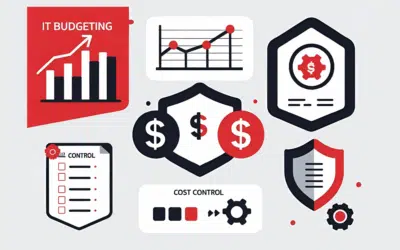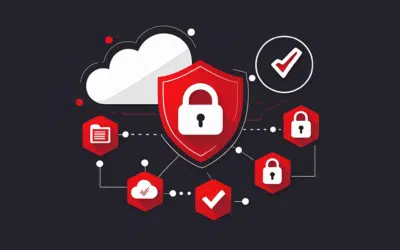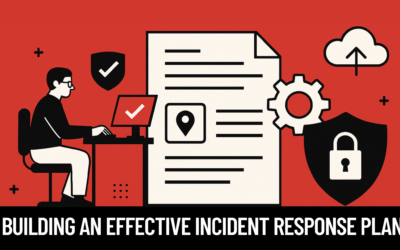Managing a small or midsize business is a challenging task, especially when it comes to IT budgeting. Every dollar counts, and it’s not always clear where to invest your resources. That’s where co-managed IT solutions come in handy. They’re designed to give you the best of both worlds – access to top-tier tech support without the full cost of an in-house team.
Co-managed IT solutions are a collaborative relationship, a partnership between your business and an IT service provider. You maintain control over your IT environment and your core business requirements while the provider supports you with additional expertise and resources (context). It’s not about completely outsourcing your IT needs or struggling to manage everything internally. Instead, it’s about finding the right balance that suits your budget and needs.
In this article, we’ll explore the world of co-managed IT services, highlighting their benefits for budget-conscious businesses. We’ll guide you through determining your IT priorities, implementing a successful co-managed solution, and we’ll even share real-world success stories to illustrate the potential impact on your business.
Regardless of your current IT challenges or budget constraints, a co-managed solution might be the key to maximizing your IT impact without breaking the bank.
Understanding Co-Managed IT Services
Definition and Core Components of Co-Managed IT
Co-managed IT is a business model where your company shares the responsibility of managing your IT needs with an external provider. This model is highly flexible and customizable to your specific needs. It revolves around a few core components:
- Shared Responsibility: Both your in-house team and the external provider work together, each bringing their unique strengths to the table.
- Expert Support: The service provider brings in-depth expertise and advanced resources that might be difficult for your in-house team to acquire.
- Control: You retain control over your IT environment, deciding which tasks to handle internally and which to delegate to the provider.
- Scalability: As your business grows, you can easily adjust the scope of services provided by your external partner.
How Co-Managed IT Differs from Fully Outsourced or In-House IT
Co-managed IT strikes a balance between fully outsourced and in-house IT management. With a fully outsourced model, you hand over all IT responsibilities to an external provider. While this might free up your time, it also means losing control over your IT operations. On the other hand, managing IT in-house gives you full control but can be costly and challenging, especially when dealing with complex IT issues.
Co-managed IT combines the best of both worlds. You maintain control over your IT environment while getting the expert support you need. Your in-house team can focus on strategic tasks, while the co-managed IT provider takes care of routine maintenance, updates, and other tasks that require specialized knowledge. This way, you get the support you need without giving up control or straining your budget.
Benefits of Co-Managed IT for Budget-Conscious Businesses
Cost Savings from Shared Responsibilities
Significant cost savings are often one of the main benefits of co-managed IT services. With shared responsibilities, your business can effectively distribute IT tasks between your in-house team and your external provider. This means you don’t have to shoulder the full cost of maintaining a comprehensive in-house IT team. Tasks that require specialized skills can be handled by the provider, while your in-house team can focus on core business operations. This model not only saves you money but also allows you to allocate resources more efficiently.
Access to Expertise Without the Price Tag of a Full-Time Hire
Having access to expert IT knowledge and skills is essential for any business. However, hiring full-time IT professionals can be expensive. Co-managed IT services provide a cost-effective solution. Your business gains access to a team of IT experts, each with their own areas of specialization, without the cost of full-time salaries, benefits, and training. You’ll have the expertise you need, when you need it, without the hefty price tag.
Scalability to Adjust as Per Your Budget and Needs
Another significant benefit of co-managed IT services is scalability. Business growth means that IT and technology needs will change. With a co-managed IT model, you can easily adjust the level of service provided to match your current needs and budget. This means you’re not locked into a one-size-fits-all package. Instead, you have the flexibility to scale up or down as required. The key benefits of this scalability include:
- Flexibility: You can quickly adapt your IT services to match changes in your business size, operations, or budget.
- Cost-Efficiency: Consumption based pricing means that you only end up paying for the services you need, helping to keep your IT budget under control.
- Growth Support: As your business expands, your co-managed IT provider can support this growth by providing additional resources and expertise.
Overall, co-managed IT services offer a flexible, cost-effective solution for budget-conscious businesses. By sharing responsibilities, accessing expert support, and scaling services to match your needs, you can maximize your IT impact while keeping costs in check.
Determining Your IT Priorities
The Importance of IT Assessments
Before you dive into co-managed IT services, it’s crucial to assess your current IT landscape. This involves identifying your business’s unique IT needs, strengths, and weaknesses. An IT assessment gives you a clear picture of where you stand and helps you identify areas that need attention. It’s like a health check-up for your IT infrastructure. You wouldn’t want to start a new diet or exercise plan without knowing your current health status, right? The same principle applies to your IT environment.
Identifying Crucial Areas: Security, Infrastructure, Software, and User Support
Next, it’s time to focus on the critical areas of your IT landscape. These typically include security, infrastructure, software, and user support. Each of these areas plays a vital role in your business’s overall IT health. For instance, security is paramount to protect your business data, intellectual property, and brand reputation with customers. Infrastructure and software are the backbone of your IT operations, and user support ensures your employees can work efficiently. It’s like the four wheels of a car – you need all of them to run smoothly for a successful journey.
Allocating Budget Based on Risk and Operational Importance
Once you’ve identified your key IT areas, it’s time to allocate your budget. This isn’t a one-size-fits-all process. The distribution of your budget ought to depend on the level of risk and significance of operations. High-risk areas, like security, might require a larger chunk of your budget. On the other hand, areas that directly impact your daily operations, like user support, should also be prioritized. Think of it as a balancing act – you want to distribute your budget in a way that mitigates risk and ensures smooth operations.
Tips for Successful Co-Managed IT Implementation
Communicating Clearly with Your Service Provider
When you start your journey with co-managed IT services, clear communication with your provider is essential. Make sure you articulate your business needs, goals, and budget constraints effectively. This helps your provider understand your expectations and tailor their services accordingly. Regular meetings, updates, and reports are also key to maintaining a healthy partnership. Remember, your service provider is your ally in achieving your IT goals, so keep the lines of communication open.
Regularly Reviewing and Adjusting the Scope of Services
Co-managed IT services offer flexibility, but it’s up to you to take advantage of it. Regularly review the services you’re receiving and adjust them as needed. This could mean scaling up when your business grows or scaling down during slower periods. Don’t hesitate to ask for changes if something isn’t working for you. After all, co-managed IT services are designed to adapt to your business’s unique needs.
Ensuring Internal Teams and the External Provider are Aligned
Co-managed IT services involve both your internal team and an external provider. For the best results, these two groups need to work in harmony. Make sure your internal team understands the role of the external provider and vice versa. Regular meetings, team building activities, and clear delineation of responsibilities can help foster this alignment. When everyone is on the same page, your co-managed IT services will function more smoothly and effectively.
Real-World Scenarios: Co-Managed IT Success Stories
Case Study of a Business That Successfully Transitioned to Co-Managed IT
Let’s consider a real-life example. A Dallas-based retail company, struggling with IT budget constraints, decided to transition to a co-managed IT model. They partnered with Axxys Technologies for specialized IT support while maintaining an in-house team for daily operations. The result? A smoother IT operation with less downtime and increased productivity. The co-managed model allowed them to leverage expert support for complex tasks such as cybersecurity and network optimization, freeing up their internal team to focus on strategic business operations.
Demonstrating ROI and Operational Improvements from Co-Managed IT
The same company experienced significant improvements in their return on investment (ROI) within a year of implementing co-managed IT services. They reported a 30% reduction in IT-related expenses, thanks to shared responsibilities and access to specialized expertise without the cost of full-time hires. Additionally, they saw an increase in operational efficiency due to reduced IT issues and faster resolution times. These improvements directly contributed to the company’s bottom line, proving that co-managed IT is a viable, cost-effective solution for small and midsized businesses.
Conclusion
So, are you ready to take the leap and explore the potential of co-managed IT for your business? Remember, it’s all about finding the right balance that suits your budget and needs. At Axxys Technologies, we’re here to guide you through this journey, offering expertise and support tailored to your unique circumstances. Don’t let budget constraints hold you back from maximizing your IT impact. Reach out to us today, and let’s make IT work for you!








